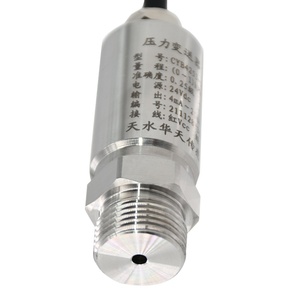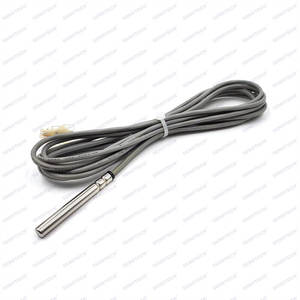
All categories
Featured selections
Trade Assurance
Buyer Central
Help Center
Get the app
Become a supplier

(43149 products available)

































Sensors for cylinders have different names depending on their use cases and the information they measure. Here are some common types of cylinder sensors:
Here are the specifications and maintenance considerations for cylinder sensors:
Sensor Type
Different types of sensors have their unique features.
Proximity sensors: They detect the position of the cylinder without physical contact. They have a sensing distance that enables them to detect the present location of the cylinder.
Magnetic sensors: They use magnets to determine the position of the cylinder. The magnetic field strength determines the position of the magnet relative to the sensor.
Displacement sensors: They measure the distance between the sensor and the cylinder's surface. The measurement range indicates the maximum distance the sensor can detect.
Pressure sensors: They measure the pressure of fluids inside the cylinder. The measurement range indicates the minimum and maximum pressures the sensor can measure.
Temperature sensors: They measure the temperature of the fluid inside the cylinder. The temperature range indicates the temperatures the sensor can measure.
Load sensors: They measure the weight of the contents inside the cylinder. The measurement capacity indicates the maximum weight the sensor can measure.
Sensor performance
Accuracy
It ensures that the sensor provides precise measurements or reliable position detection. It eliminates the need for frequent calibration or adjustment of the sensor's performance.
Resolution
It is the smallest change the sensor can detect. For example, if a displacement sensor has a resolution of 0.1 mm, it can measure changes in distance as small as 0.1 mm.
Response time
It is the time taken by a sensor to detect a change and send a signal. For instance, if a pressure sensor takes 0.5 seconds to notice a pressure change and alert the system, it has a 0.5-second response time.
Hysteresis
It is the difference in a sensor's reading when a value is rising compared to when it is falling. For example, if a load sensor shows 100 kg when the weight is increasing and 98 kg when it is decreasing, it has a 2 kg hysteresis.
Linearity
It is the closeness of a sensor's readings to a straight line. For example, if a temperature sensor measures 10°C, 20°C, 30°C, and 40°C, and the readings are on a straight line, it has good linearity.
Stability
It is the consistency of a sensor's readings over time. For instance, if a proximity sensor keeps giving the same distance reading every time it measures, it has good stability.
Maintenance
Regular inspection
Inspect the sensors regularly to ensure they are in good condition. Look for wear, damage, or dirt that may affect their performance.
Cleaning
Clean the sensors periodically. Use a soft cloth or brush to remove dust or dirt. Avoid harsh chemicals or materials that may damage the sensors.
Calibration
Calibrate the sensors as recommended by the manufacturer. This ensures they provide accurate measurements. Follow the instructions for the correct calibration procedures.
Wiring and connections
Check the wiring and connections of the sensors. Ensure they are secure and free from damage. Loose connections can cause unreliable readings.
Environmental considerations
Be aware of the environmental conditions where the sensors are installed. Extreme temperatures, moisture, or exposure to harsh chemicals can affect their performance.
Spare parts
Use genuine spare parts recommended by the sensor manufacturer. This ensures compatibility and reliability. Avoid using cheap or counterfeit parts that may not work properly.
Follow safety precautions
When performing maintenance, follow safety precautions. Turn off the system before handling the sensors. Follow the manufacturer's instructions for safe handling and maintenance procedures.
Sensor replacement
Replace sensors that show signs of wear or damage. Old or faulty sensors can give wrong measurements, which can affect the system's performance.
Choosing the right cylinder sensor for a specific application can be challenging due to the variety of models available on the market. Here are some factors.Storage capacity and number of channels
Storage capacity
When choosing a cylinder sensor, consider its storage capacity. The storage capacity determines how much data can be stored on the sensor. Users can retrieve the data later if the sensor has a larger storage capacity. A sensor with higher storage capacity is ideal if long-term monitoring and tracking of cylinder usage are required. This is because it reduces the frequency of data transfer.
Number of channels
When choosing a cylinder sensor, the number of channels is an important factor to consider. The number of channels indicates how many cylinders the sensor can monitor simultaneously. Each channel corresponds to a single cylinder, allowing real-time monitoring of its status and usage. A sensor with multiple channels can monitor several cylinders at once, which is useful in cases where multiple cylinders are connected to a single supply network. It provides a comprehensive overview of the status and usage of all cylinders, enabling better tracking and management.
Choosing a sensor with the right number of channels allows users to select the most suitable option based on their specific needs and requirements.
Wireless connectivity
Wireless connectivity is an important aspect to consider when selecting a cylinder sensor. Cylinder sensors with wireless connectivity can communicate with other devices through wireless networks. This enables the transmission of real-time data and status information from the sensor to other connected devices, such as mobile phones, tablets, or computers, without the need for physical cables or connections. Depending on the specific needs and requirements, several types of wireless connectivity options are available.
Compatibility with monitoring systems
When choosing a cylinder sensor, consider its compatibility with monitoring systems. Ensuring compatibility between the sensor and the monitoring system is important to guarantee smooth communication and data transmission. Check the communication protocols supported by the sensor and the monitoring system. This ensures that they can interact and exchange data correctly.
Additionally, consider the compatibility of other aspects, such as the operating system of the connected devices and any required software or applications for data visualization and analysis. Choosing a sensor compatible with the monitoring system simplifies integration and allows utilizing the full potential of real-time monitoring and tracking of cylinder usage.
Working with sensors for cylinders can be quite technical. However, with the right knowledge, it can be a DIY-friendly task. Here is a simple guide on how to diy and replace cylinder sensors.
Before anything else, it is important to know that there are different types of sensors for different sizes and models of vehicles. The steps may vary depending on the type of sensor. But, one thing that is common is to ensure that the old sensor is cleaned up before removing it. This will prevent debris from falling into the engine when the sensor is being replaced.
Prepare the new sensor for installation. It’s important to check the user manual to see if it requires any preparation before installation. For instance, some sensors may require a fresh coating of oil on the tip.
Find the location of the old sensor. It is advisable to refer to the vehicle's service manual to get the exact location of the sensor. It may be difficult to locate the sensor by just looking up or down the engine.
After locating the sensor, use a wrench to unscrew the bolts holding the sensor in place. Gently wiggle the sensor to remove it from its position. Depending on how tight it was inserted, this step may require a little force.
Now that the old sensor has been removed, it’s time to install the new sensor. Carefully place the new sensor into its mounting point. Make sure it is positioned in the right direction before tightening the bolts to avoid damaging it.
After tightening the bolts, reconnect the electrical connector. It’s important to ensure that the connector is firmly attached to avoid interruptions while driving the vehicle.
Double check to make sure everything is in place. Go through the steps to ensure that nothing has been left out. When the user is sure that everything is in place, start the vehicle's engine to see if it runs smoothly.
It's that simple! Once the driver feels that the engine is running well, they can close the hood and drive away.
Q1. How do users know that a sensor in a cylinder has a problem?
A1. There are different ways to know that a sensor for a cylinder has a problem. One of them is through the check engine light on the dashboard. When this light comes on, it could indicate a problem with one of the sensors. Users can also use an OBD-II scanner to read error codes from the car's computer. Some codes point directly to a faulty sensor. Apart from these two methods, there are physical signs like decreased engine performance, increased emissions, rough idling, or even issues when starting the car.
Q2. Can a car run without sensors?
A2. Sensors are crucial for a car's operation. They help the engine run smoothly and ensure emissions stay in check. While the car can technically run without functioning sensors for a limited time, it is not advisable. The sensors for cylinders help optimize fuel efficiency and performance. Without them, the car may consume more fuel and run inefficiently. Moreover, driving a car with faulty sensors can lead to further engine damage and increased emissions, which is bad for the environment.
Q3. Have sensor technologies for cylinders changed recently?
A3. Yes, there have been advancements in technology recently. Traditional sensors use basic technologies like switches or variable resistors. But now, advanced sensors are available. They provide more precise measurements and faster responses. These new sensors can improve engine performance and reduce emissions. They also contribute to better fuel efficiency.
Q4. Can hobbyists install new sensors in a cylinder themselves?
A4. Many sensors are easy to access and install. Manufacturers provide detailed instructions in user manuals. If the hobbyist is good with tools and knows a bit about car mechanics, they might replace some sensors. But, it is a good idea to double-check everything. Users can use an OBD-II scanner to ensure all is well after the installation.
Q5: What should users do if the engine runs smoothly after changing a sensor?
A5: It would mean that the new sensor is working properly. The old problem was most likely linked to the old sensor. The change might have fixed the issue. Please keep monitoring the engine performance. If the problems come back, the user should check the other sensors.